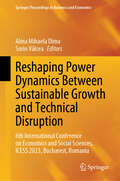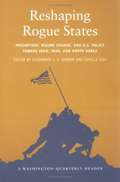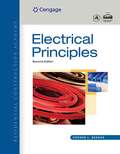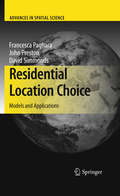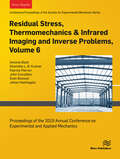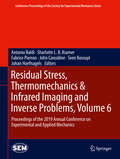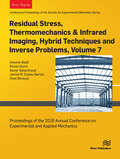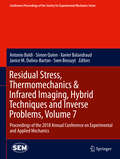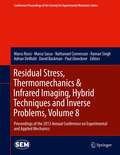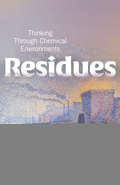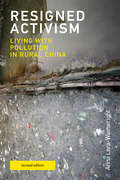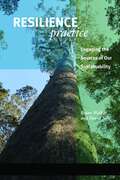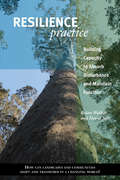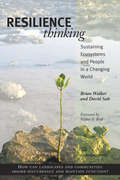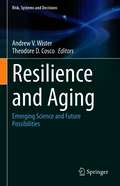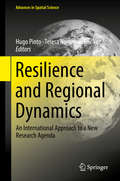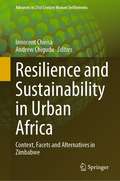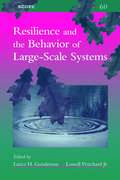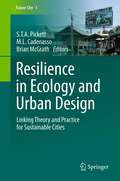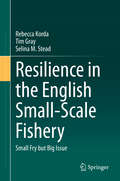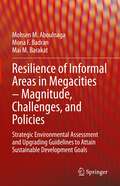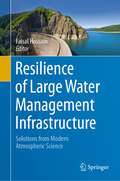- Table View
- List View
Reshaping Power Dynamics Between Sustainable Growth and Technical Disruption: 6th International Conference on Economics and Social Sciences, ICESS 2023, Bucharest, Romania (Springer Proceedings in Business and Economics)
by Alina Mihaela Dima Sorin VâlceaThis book covers various topics related to economics and the social sciences, such as artificial intelligence, sustainability, ESG, and tax administration. The respective contributions provide insights and perspectives on the current challenges and opportunities in these fields, while also showcasing the latest research and innovations from scholars and practitioners around the world. The book is based on the papers presented at the 6th International Conference on Economics and Social Sciences, ICESS 2023, which was held in Bucharest, Romania.
Reshaping Rogue States: Preemption, Regime Change, and U.S. Policy Toward Iran, Iraq, and North Korea
by Alexander T. J. Lennon Camille EissIn January 2002, President George W. Bush declared Iran, Iraq, and North Korea constituents of an "axis of evil."
Reshaping of Dirac Cones in Topological Insulators and Graphene (Springer Theses)
by Álvaro Díaz FernándezDirac cones are ubiquitous to non-trivial quantum matter and are expected to boost and reshape the field of modern electronics. Particularly relevant examples where these cones arise are topological insulators and graphene. From a fundamental perspective, this thesis proposes schemes towards modifying basic properties of these cones in the aforementioned materials. The thesis begins with a brief historical introduction which is followed by an extensive chapter that endows the reader with the basic tools of symmetry and topology needed to understand the remaining text. The subsequent four chapters are devoted to the reshaping of Dirac cones by external fields and delta doping. At all times, the ideas discussed in the second chapter are always a guiding principle to understand the phenomena discussed in those four chapters. As a result, the thesis is cohesive and represents a major advance in our understanding of the physics of Dirac materials.
Residential Construction Academy: Electrical Principles
by Stephen L. HermanThe student workbook/lab manual is designed to help your students retain key chapter content. Included within this resource are chapter objective questions, key term definition queries, multiple choice, fill in the blank and true or false problems. The student workbook/laboratory manual is a valuable tool designed to enhance your students' lab experience. Lab activities, objectives, materials lists, step-by-step procedures, illustrations, and review questions are commonly found.
Residential Location Choice: Models and Applications
by John Preston David Simmonds Francesca PagliaraThe effective planning of residential location choices is one of the great challenges of contemporary societies and requires forecasting capabilities and the consideration of complex interdependencies which can only be handled by complex computer models. This book presents a range of approaches used to model residential locations within the context of developing land-use and transport models. These approaches illustrate the range of choices that modellers have to make in order to represent residential choice behaviour. The models presented in this book represent the state-of-the-art and are valuable both as key building blocks for general urban models, and as representative examples of complexity science.
Residual Stress, Thermomechanics & Infrared Imaging and Inverse Problems, Volume 6: Proceedings of the 2019 Annual Conference on Experimental and Applied Mechanics
by Sven Bossuyt Antonio Baldi Johan Hoefnagels Kramer, Sharlotte L. B. John Considine, Fabrice PierronResidual Stress, Thermomechanics & Infrared Imaging and Inverse Problems, Volume 6 of the Proceedings of the 2019 SEM Annual Conference & Exposition on Experimental and Applied Mechanics, the sixth volume of six from the Conference, brings together contributions to this important area of research and engineering. The collection presents early findings and case studies on a wide range of areas, including: Test Design and Inverse Method Algorithms Inverse Problems: Virtual Fields Method Residual Stresses: Measurement, Uncertainty & Validation Residual Stresses: Eigenvalues, Modeling, & Crack Growth Material Characterizations Using Thermography Fatigue, Damage & Fracture Evaluation Using Infrared Thermography.
Residual Stress, Thermomechanics & Infrared Imaging and Inverse Problems, Volume 6: Proceedings of the 2019 Annual Conference on Experimental and Applied Mechanics (Conference Proceedings of the Society for Experimental Mechanics Series)
by John Considine Sven Bossuyt Antonio Baldi Sharlotte L. B. Kramer Fabrice Pierron Johan HoefnagelsResidual Stress, Thermomechanics & Infrared Imaging and Inverse Problems, Volume 6 of the Proceedings of the 2019 SEM Annual Conference & Exposition on Experimental and Applied Mechanics, the sixth volume of six from the Conference, brings together contributions to this important area of research and engineering. The collection presents early findings and case studies on a wide range of areas, including: Test Design and Inverse Method Algorithms Inverse Problems: Virtual Fields Method Residual Stresses: Measurement, Uncertainty & Validation Residual Stresses: Eigenvalues, Modeling, & Crack Growth Material Characterizations Using Thermography Fatigue, Damage & Fracture Evaluation Using Infrared Thermography
Residual Stress, Thermomechanics & Infrared Imaging, Hybrid Techniques and Inverse Problems, Volume 7: Proceedings of the 2018 Annual Conference on Experimental and Applied Mechanics
by Sven Bossuyt Simon Quinn Xavier Balandraud Antonio Baldi Dulieu-Barton, Janice M.Residual Stress, Thermomechanics & Infrared Imaging, Hybrid Techniques and Inverse Problems, Volume 7 of the Proceedings of the 2018 SEM Annual Conference & Exposition on Experimental and Applied Mechanics, the seventh volume of eight from the Conference, brings together contributions to this important area of research and engineering. The collection presents early findings and case studies on a wide range of areas, including: Inverse Problems/Hybrid Techniques Material Characterizations Using Thermography Thermoelastic Stress Analysis Fatigue & Damage Evaluation Using Infrared Thermography Integration of Infrared Thermography & DIC Thermographic Non-Destructive Evaluation (NDE).
Residual Stress, Thermomechanics & Infrared Imaging, Hybrid Techniques and Inverse Problems, Volume 7: Proceedings of the 2018 Annual Conference on Experimental and Applied Mechanics (Conference Proceedings of the Society for Experimental Mechanics Series)
by Sven Bossuyt Simon Quinn Xavier Balandraud Antonio Baldi Janice M. Dulieu-BartonResidual Stress, Thermomechanics & Infrared Imaging, Hybrid Techniques and Inverse Problems, Volume 7 of the Proceedings of the 2018 SEM Annual Conference & Exposition on Experimental and Applied Mechanics, the seventh volume of eight from the Conference, brings together contributions to this important area of research and engineering. The collection presents early findings and case studies on a wide range of areas, including: Inverse Problems/Hybrid TechniquesMaterial Characterizations Using ThermographyThermoelastic Stress AnalysisFatigue & Damage Evaluation Using Infrared ThermographyIntegration of Infrared Thermography & DICThermographic Non-Destructive Evaluation (NDE)
Residual Stress, Thermomechanics & Infrared Imaging, Hybrid Techniques and Inverse Problems, Volume 8: Proceedings of the 2013 Annual Conference on Experimental and Applied Mechanics
by Marco Rossi David Backman Paul Gloeckner Adrian Dewald Marco Sasso Nathanael Connesson Raman SinghResidual Stress, Thermomechanics & Infrared Imaging, Hybrid Techniques and Inverse Problems, Volume 8: Proceedings of the 2013 Annual Conference on Experimental and Applied Mechanics, the eighth volume of eight from the Conference, brings together contributions to this important area of research and engineering. The collection presents early findings and case studies on a wide range of areas, including: Advances in Residual Stress Measurement Methods Residual Stress Effects on Material Performance Optical, Ultrasonic, and Diffraction Methods for Residual Stress Measurement Thermomechanics & Infrared Imaging Inverse Methods Inverse Methods in Plasticity Applications in Experimental Mechanics
Residues: Thinking Through Chemical Environments (Nature, Society, and Culture)
by Nathalie Jas Soraya Boudia Scott Frickel Carsten Reinhardt Angela N. Creager Emmanuel Henry Jody A. RobertsResidues offers readers a new approach for conceptualizing the environmental impacts of chemicals production, consumption, disposal, and regulation. Environmental protection regimes tend to be highly segmented according to place, media, substance, and effect; academic scholarship often reflects this same segmented approach. Yet, in chemical substances we encounter phenomena that are at once voluminous and miniscule, singular and ubiquitous, regulated yet unruly. Inspired by recent studies of materiality and infrastructures, we introduce “residual materialism” as a framework for attending to the socio-material properties of chemicals and their world-making powers. Tracking residues through time, space, and understanding helps us see how the past has been built into our present chemical environments and future-oriented regulatory systems, why contaminants seem to always evade control, and why the Anthropocene is as inextricably harnessed to the synthesis of carbon into new molecules as it is driven by carbon’s combustion.
Resigned Activism, revised edition: Living with Pollution in Rural China (Urban and Industrial Environments)
by Anna Lora-WainwrightAn examination of the daily grind of living with pollution in rural China and of the varying forms of activism that develop in response.Residents of rapidly industrializing rural areas in China live with pollution every day. Villagers drink obviously tainted water and breathe visibly dirty air, afflicted by a variety of ailments—from arthritis to nosebleeds—that they ascribe to the effects of industrial pollution. In Resigned Activism, Anna Lora-Wainwright explores the daily grind of living with pollution in rural China and the varying forms of activism that develop in response. This revised edition offers expanded acknowledgment of the contributions of Lora-Wainwright&’s collaborators in China.Lora-Wainwright finds that claims of health or environmental damage are politically sensitive, and that efforts to seek redress are frustrated by limited access to scientific evidence, growing socioeconomic inequalities, and complex local realities. Villagers, feeling powerless, often come to accept pollution as part of the environment; their activism is tempered by their resignation. Drawing on fieldwork done with teams of collaborators, Lora-Wainwright offers three case studies of &“resigned activism&” in rural China, examining the experiences of villagers who live with the effects of phosphorous mining and fertilizer production, lead and zinc mining, and electronic waste processing. The book also includes extended summaries of the in-depth research carried out by Ajiang Chen and his team in some of China&’s &“cancer villages,&” village-sized clusters of high cancer incidence. These cases make clear the staggering human costs of development and the deeply uneven distribution of costs and benefits that underlie China&’s economic power.
Resilience Practice: Building Capacity To Absorb Disturbance And Maintain Function
by Brian Walker & David SaltIn 2006, Resilience Thinking addressed an essential question: As the natural systems that sustain us are subjected to shock after shock, how much can they take and still deliver the services we need from them? This idea caught the attention of both the scientific community and the general public. In Resilience Practice, authors Brian Walker and David Salt take the notion of resilience one step further, applying resilience thinking to real-world situations and exploring how systems can be managed to promote and sustain resilience. The book begins with an overview and introduction to resilience thinking and then takes the reader through the process of describing systems, assessing their resilience, and intervening as appropriate. Following each chapter is a case study of a different type of social-ecological system and how resilience makes a difference to that system in practice. The final chapters explore resilience in other arenas, including on a global scale. Resilience Practice will help people with an interest in the “coping capacity” of systems—from farms and catchments to regions and nations—to better understand how resilience thinking can be put into practice. It offers an easy-to-read but scientifically robust guide through the real-world application of the concept of resilience and is a must read for anyone concerned with the management of systems at any scale.
Resilience Practice: Building Capacity to Absorb Disturbance and Maintain Function
by Brian Walker David SaltIn 2006, Resilience Thinking addressed an essential question: As the natural systems that sustain us are subjected to shock after shock, how much can they take and still deliver the services we need from them? This idea caught the attention of both the scientific community and the general public. In Resilience Practice, authors Brian Walker and David Salt take the notion of resilience one step further, applying resilience thinking to real-world situations and exploring how systems can be managed to promote and sustain resilience. The book begins with an overview and introduction to resilience thinking and then takes the reader through the process of describing systems, assessing their resilience, and intervening as appropriate. Following each chapter is a case study of a different type of social-ecological system and how resilience makes a difference to that system in practice. The final chapters explore resilience in other arenas, including on a global scale. Resilience Practice will help people with an interest in the "coping capacity" of systems--from farms and catchments to regions and nations--to better understand how resilience thinking can be put into practice. It offers an easy-to-read but scientifically robust guide through the real-world application of the concept of resilience and is a must read for anyone concerned with the management of systems at any scale.
Resilience Thinking: Sustaining Ecosystems and People in a Changing World
by Brian Walker David Salt Walter ReidIncreasingly, cracks are appearing in the capacity of communities, ecosystems, and landscapes to provide the goods and services that sustain our planet's well-being. The response from most quarters has been for "more of the same" that created the situation in the first place: more control, more intensification, and greater efficiency. "Resilience thinking" offers a different way of understanding the world and a new approach to managing resources. It embraces human and natural systems as complex entities continually adapting through cycles of change, and seeks to understand the qualities of a system that must be maintained or enhanced in order to achieve sustainability. It explains why greater efficiency by itself cannot solve resource problems and offers a constructive alternative that opens up options rather than closing them down. In Resilience Thinking, scientist Brian Walker and science writer David Salt present an accessible introduction to the emerging paradigm of resilience. The book arose out of appeals from colleagues in science and industry for a plainly written account of what resilience is all about and how a resilience approach differs from current practices. Rather than complicated theory, the book offers a conceptual overview along with five case studies of resilience thinking in the real world. It is an engaging and important work for anyone interested in managing risk in a complex world.
Resilience Thinking: Sustaining Ecosystems and People in a Changing World
by Brian Walker David Salt Walter ReidIncreasingly, cracks are appearing in the capacity of communities, ecosystems, and landscapes to provide the goods and services that sustain our planet's well-being. The response from most quarters has been for "more of the same" that created the situation in the first place: more control, more intensification, and greater efficiency. "Resilience thinking" offers a different way of understanding the world and a new approach to managing resources. It embraces human and natural systems as complex entities continually adapting through cycles of change, and seeks to understand the qualities of a system that must be maintained or enhanced in order to achieve sustainability. It explains why greater efficiency by itself cannot solve resource problems and offers a constructive alternative that opens up options rather than closing them down. In Resilience Thinking, scientist Brian Walker and science writer David Salt present an accessible introduction to the emerging paradigm of resilience. The book arose out of appeals from colleagues in science and industry for a plainly written account of what resilience is all about and how a resilience approach differs from current practices. Rather than complicated theory, the book offers a conceptual overview along with five case studies of resilience thinking in the real world. It is an engaging and important work for anyone interested in managing risk in a complex world.
Resilience and Aging: Emerging Science and Future Possibilities (Risk, Systems and Decisions)
by Andrew V. Wister Theodore D. CoscoOlder aged adults face many adversities over the later life course. This edited volume will address the ways in which seniors bounce back from different types and combinations of adversity – termed “resilience”. While research has been accumulating that identifies inherent abilities and external resources needed to adapt and navigate stress-inducing experiences among aging and older adults, gaps remain in understanding the unique elements and processes of resilience. A series of chapters included in this book will address several overarching questions: why do some older individuals/families/communities adapt to adversity better than others; what are modifiable behavioral protective/risk factors related to resilience; and how can we foster resilience at the individual/community level and which approaches show the most promise?The spectrum of aging-related challenges and responses addressed in this book include: mental health; physical/functional health problems; multimorbidity; socio-economic deprivation; social isolation and loneliness; cultural dimensions of loneliness; housing/homelessness problems; and environmental disasters. This book presents cutting-edge science at the conceptual, methodological, empirical and practice levels applied to emerging resilience sub-fields in gerontology. It will also present potential areas of future research, policy and practice linked to these areas.During a period of the most rapid population aging in the US, Canada and many other nations, coupled with heightened global socio-political change, extending our knowledge of resilience will help society to make important adjustments to maximize health and wellness of older individuals. Supporting and enhancing resilience through technological, social and/or community-level advances in geroscience will help those facing adversity to thrive by harnessing, stretching, and leveraging a wide array of potential resources. The promotion of healthier older populations has far-reaching consequences for health care and social/community support systems, both in terms of public health including pandemic response, and the development and implementation of innovations in treatment and practice guidelines.
Resilience and Food Security in a Food Systems Context (Palgrave Studies in Agricultural Economics and Food Policy)
by Stephen Devereux Christophe BénéThis open access book compiles a series of chapters written by internationally recognized experts known for their in-depth but critical views on questions of resilience and food security. The book assesses rigorously and critically the contribution of the concept of resilience in advancing our understanding and ability to design and implement development interventions in relation to food security and humanitarian crises. For this, the book departs from the narrow beaten tracks of agriculture and trade, which have influenced the mainstream debate on food security for nearly 60 years, and adopts instead a wider, more holistic perspective, framed around food systems. The foundation for this new approach is the recognition that in the current post-globalization era, the food and nutritional security of the world’s population no longer depends just on the performance of agriculture and policies on trade, but rather on the capacity of the entire (food) system to produce, process, transport and distribute safe, affordable and nutritious food for all, in ways that remain environmentally sustainable. In that context, adopting a food system perspective provides a more appropriate frame as it incites to broaden the conventional thinking and to acknowledge the systemic nature of the different processes and actors involved. This book is written for a large audience, from academics to policymakers, students to practitioners.This is an open access book.
Resilience and Regional Dynamics: An International Approach to a New Research Agenda (Advances in Spatial Science)
by Hugo Pinto Teresa Noronha Eric VazEconomic and financial crises have brought the rise of unemployment, reduction of economic growth and emergence of global imbalances and tensions as countries and regions have suffered the effects of a variety of internal and external shocks. In this context of constant disruption, the scientific community has struggled to provide satisfactory answers to current economic challenges within standard frameworks. Focusing on the interconnections between innovation and resilience, this edited book contributes to a better understanding of how the crisis affects innovation and the capacity of territories to adapt and evolve. It offers both theoretical and empirical contributions that debate the notions of resilience in regional and urban contexts and serve as case studies related to innovation strategies and territorial clusters.
Resilience and Sustainability in Urban Africa: Context, Facets and Alternatives in Zimbabwe (Advances in 21st Century Human Settlements)
by Innocent Chirisa Andrew ChiguduResilience has become a very topical issue transcending many spheres and sectors of sustainable urban development. This book presents a resilience framework for sustainable cities and towns in Africa. The rise in informal settlements is due to the urban planning practices in most African cities that rarely reflect the realities of urban life and environment for urban development. Aspects of places, people and process are central to the concept of urban resilience and sustainable urban growth. It stems from the observation that urban vulnerability is on the increase in Zimbabwe and beyond. In history, disasters have adversely affected nations across the world, inflicting wide ranging losses on one hand while on the other hand creating development opportunities for urban communities. Cooperation in disaster management is a strategy for minimising losses and uplifting the affected urban settlements. The significance of urban planning and design in the growth and development of sustainable urban centres is well documented. Urbanisation has brought with it challenges that most developing countries such as Zimbabwe are not equipped to handle. This has been accompanied by problems such as overpopulation, overcrowding, shortages of resources and the growth of slum settlements. There need is to seriously consider urban planning and design in order to come up with contemporary designs that are resilient to current urban challenges. There are major gaps in urban resilience building for instance in Harare and the local authority needs to prioritise investment in resilient urban infrastructure.
Resilience and the Behavior of Large-Scale Systems (SCOPE Series #60)
by Lance H. Gunderson Lowell PritchardScientists and researchers concerned with the behavior of large ecosystems have focused in recent years on the concept of "resilience." Traditional perspectives held that ecological systems exist close to a steady state and resilience is the ability of the system to return rapidly to that state following perturbation. However, beginning with the work of C. S. Holling in the early 1970s, researchers began looking at conditions far from the steady state, where resilience is measured by the magnitude of disturbance that can be absorbed before the system is restructured.Resilience and the Behavior of Large-Scale Systems examines theories of resilience and change, offering readers a thorough understanding of how the properties of ecological resilience and human adaptability interact in complex, regional-scale systems. The book addresses theoretical concepts of resilience and stability in large-scale ecosystems and the empirical application of those concepts in a diverse set of cases. In addition, it discusses the practical implications of new theoretical approaches and their role in the sustainability of human-modified ecosystems.The book begins with a review of key properties of complex adaptive systems that contribute to overall resilience, including multiple equlibria, complexity, self-organization at multiple scales, and order. Following the introduction are case studies that explore the biophysical dimensions of resilience in terrestrial and aquatic systems, and evaluate the propositions presented. The book concludes with a synthesis section that revisits propositions in light of the case studies, while an appendix presents a detailed account of the relationship between return times for a disturbed system and its resilience.In addition to the editors, contributors include Stephen R. Carpenter, Carl Folke, C. S. Holling, Bengt-Owe Jansson, Donald Ludwig, Ariel Lugo, Tim R. McClanahan, Garry D. Peterson, and Brian H. Walker.
Resilience in Ecology and Urban Design
by S.T.A. Pickett Brian Mcgrath M. L. CadenassoThe contributors to this volume propose strategies of urgent and vital importance that aim to make today's urban environments more resilient. Resilience, the ability of complex systems to adapt to changing conditions, is a key frontier in ecological research and is especially relevant in creative urban design, as urban areas exemplify complex systems. With something approaching half of the world's population now residing in coastal urban zones, many of which are vulnerable both to floods originating inland and rising sea levels, making urban areas more robust in the face of environmental threats must be a policy ambition of the highest priority. The complexity of urban areas results from their spatial heterogeneity, their intertwined material and energy fluxes, and the integration of social and natural processes. All of these features can be altered by intentional planning and design. The complex, integrated suite of urban structures and processes together affect the adaptive resilience of urban systems, but also presupposes that planners can intervene in positive ways. As examples accumulate of linkage between sustainability and building/landscape design, such as the Shanghai Chemical Industrial Park and Toronto's Lower Don River area, this book unites the ideas, data, and insights of ecologists and related scientists with those of urban designers. It aims to integrate a formerly atomized dialog to help both disciplines promote urban resilience.
Resilience in the English Small-Scale Fishery: Small Fry but Big Issue
by Tim Gray Selina M. Stead Rebecca KordaThis book is a contribution to our understanding of the worrying situation of small-scale fisheries (SSF) which face marginalisation in most coastal countries. The authors explain why SSF are so pressured; how there has been a powerful backlash against this marginalisation during the last 30 years; what are the main ideational currents supporting this backlash; and what is the enduring value of SSF that justifies that support. The authors discuss the major contemporary interpretations of SSF; the challenges facing SSF globally and in England; and SSF’s coping strategies in response to those challenges through the framework of resilience theory. In an innovative analysis, the authors show how there are three kinds of resilience: passive resilience (where fishers are resigned to their adverse fate), adaptive resilience (where fishers make the best use of the opportunities that are available to them), and transformative resilience (where fishers attempt to change the system that faces them). The authors draw on an extensive range of interview data to provide rich insights into the world of SSF, and they discuss a variety of proposals for improving their conditions. The book will appeal to the growing academic and public community that is following with increasing concern the debate about the future of SFF, and to the environmental movement which has committed itself to support SSF as a greener form of fishing than the large-scale industrial sector.
Resilience of Informal Areas in Megacities – Magnitude, Challenges, and Policies: Strategic Environmental Assessment and Upgrading Guidelines to Attain Sustainable Development Goals
by Mohsen M. Aboulnaga Mona F. Badran Mai M. BarakatThis book focuses on the socio-economic and sustainability challenges facing megacities in dealing with the dramatic population increases of informal areas and settlements (or slums), especially when coupled with the impacts and risks of climate change. The authors examine informal urban areas globally and in developing countries utilizing strategic environmental assessment (SEA) as a tool to solve the sequence of upgrading steps concerning slums and shanty towns, and also establish essential guidelines for local governments and stakeholders to create a balance and quality of life for slums dwellers, particularly in the age of the COVID-19 pandemic, through applying sustainability indicators that enhance the upgrading process. Coverage includes recent statistics and mapping of informal areas worldwide and assessment of the GIZ and Sir Norman Foster models in terms of energy demands and consequential emission of CO2 and air pollution from slums. Three models of Maspero’s Triangle are also studied and assessed. The book is essential reading for a wide range of researchers, students, policymakers, governments, and professionals as well as a good source for research centers and academicians working in energy, climate change, urban environments, and sustainable urban development.
Resilience of Large Water Management Infrastructure: Solutions from Modern Atmospheric Science
by Faisal HossainInfrastructure that manages our water resources (such as, dams and reservoirs, irrigation systems, channels, navigation waterways, water and wastewater treatment facilities, storm drainage systems, urban water distribution and sanitation systems), are critical to all sectors of an economy. Realizing the importance of water infrastructures, efforts have already begun on understanding the sustainability and resilience of such systems under changing conditions expected in the future. The goal of this collected work is to raise awareness among civil engineers of the various implications of landscape change and non-climate drivers on the resilience of water management infrastructure. It identifies the knowledge gaps and then provides effective and complementary approaches to assimilate knowledge discovery on local (mesoscale)-to-regional landscape drivers to improve practices on design, operations and preservation of large water infrastructure systems.
